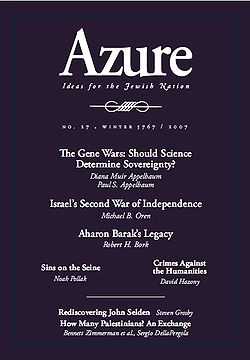Azure (magazine)
 Winter 2007 cover | |
| Editor | Assaf Sagiv |
|---|---|
| Categories | Jewish affairs, Zionism, philosophy |
| Frequency | Quarterly |
| First issue | 1996 |
| Final issue — Number |
2011 46 |
| Company | The Shalem Center |
| Country | Israel |
| Based in | Jerusalem |
| Language | English and Hebrew |
| Website | http://www.azure.org.il |
| ISSN | 0793-6664 |
Azure: Ideas for the Jewish Nation (Hebrew: תכלת) (Tchelet) was a quarterly journal published by the Shalem Center in Jerusalem, Israel. Azure published new writing on issues relating to Jewish thought and identity, Zionism, and the State of Israel. It was published in both Hebrew and English, allowing for the exchange of ideas between Israelis and Jews worldwide. [1]
Azure was established in 1996 and was originally published twice a year, but grew into a quarterly. The journal's first editor-in-chief was Ofir Haivry, followed by Daniel Polisar and David Hazony. Assaf Sagiv was editor in chief from 2007 to 2012.
Notable contributors have included Michael Oren, Yoram Hazony, Yossi Klein Halevi, A. B. Yehoshua, Ruth Gavison, Amnon Rubinstein, Natan Sharansky, Alain Finkielkraut, Amotz Asa-El, David Hazony, Meir Soloveichik, Claire Berlinski, Robert Bork, and Moshe Ya'alon.
The journal published Hebrew translations of classic essays by authors such as Immanuel Kant, David Hume, William James, G. K. Chesterton, Martin Luther King, Jr., C. S. Lewis, Alasdair MacIntyre, Winston Churchill, Matthew Arnold, and Leo Strauss.
The emphasis of the journal was on strengthening Jewish and Zionist values. It was highly critical of post-national and radical trends in academia,[2] opposed judicial activism in the Israeli legal system,[3] and supported free-market reforms in the Israeli economy.
The publication ceased operations with the Autumn issue, no. 46, alerting its subscribers to this fact mid-2012. According to the letter sent to its subscribers, "circumstances and resources no longer enable [the magazine] to continue publication."
Selected articles
- Israel’s Electoral Complex by Amotz Asa-El
- Barak’s Rule by Robert H. Bork
- Ecclesiastes: Fleeting and Timeless by Ethan Dor-Shav
- A Right Above all Others by Amitai Etzioni
- In the Name of the Other: Reflections on the Coming Antisemitism by Alain Finkielkraut
- The Jews Right to Statehood: A Defense by Ruth Gavison
- The Way of the World by Ofir Haivry
- Judaism and the Modern State by Yoram Hazony
- Circumcision as Rebellion by Ido Hevroni
- Far Away So Close by Yosef Yitzhak Lifshitz
- Did Israel Want the Six Day War? by Michael Oren
- Globalization: Just Do It & George Steiner’s Jewish Problem by Assaf Sagiv
- Redemption and the Power of Man by Meir Soleveichik
- Israel and the Palestinians: A New Strategy by Moshe Yaalon
- An Attempt to Identify the Root Cause of Antisemitism by A.B. Yehoshua
References
- ↑ University of Cincinnati libraries
- ↑ Assaf Sagiv, 'The Sad State of Israeli Radicalism,' Azure, Spring 2010
- ↑ Evelyn Gordon, 'Liberalism's Endgame,' Azure, Spring 2009